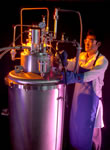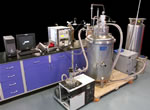
![]()
 Storing hydrogen in a liquid state gives increased energy density and is a mature technology with its use in NASA’s Space program as an excellent example. However, the issues with liquid hydrogen tanks are hydrogen boil-off, the energy required for hydrogen liquefaction, volume, weight, and tank cost. The energy demand for hydrogen liquefaction is high, consuming about 30 percent of the heating value of the hydrogen being liquefied. Hydrogen boil-off must be minimized or eliminated because of cost, efficiency, range considerations, and safety when vehicles are parked in confined spaces. If you're interested in learning more about hydrogen storage, please take a look at our Hydrogen Basics.
Storing hydrogen in a liquid state gives increased energy density and is a mature technology with its use in NASA’s Space program as an excellent example. However, the issues with liquid hydrogen tanks are hydrogen boil-off, the energy required for hydrogen liquefaction, volume, weight, and tank cost. The energy demand for hydrogen liquefaction is high, consuming about 30 percent of the heating value of the hydrogen being liquefied. Hydrogen boil-off must be minimized or eliminated because of cost, efficiency, range considerations, and safety when vehicles are parked in confined spaces. If you're interested in learning more about hydrogen storage, please take a look at our Hydrogen Basics.
FSEC has been a leader in cyrogenics. This section lists some of the previous and ongoing cryogenics research projects at FSEC.
Experimental Design & Evaluation of ZBO (zero-boil-off) Cryogenic Systems
The primary objectives of this research is to design and build a experimental test bed in order to perform hydrogen densification, ZBO storage, pressurization and boil-off loss recovery in chill-down and filling process, and in result, to obtain various handling techniques of densified hydrogen in densification, transfer and storage processes.
 Previous
NASA investigations have focused on advanced methods of producing densified
propellants, but not much work has been accomplished in the area of storing
and handling densified propellants. NASA KSC has 50+ years experience
in handling cryogenic propellants, but all that experience is with NBP
saturated liquids. This experimental effort will provide operational
techniques of continuous densification unit, ZBO storage techniques for
liquid and densified liquid hydrogen, densification enhancement using
cryocooler and heat pipe, pressurization techniques for transportation,
handling of thermal stratification layers in storage tank, liquefaction
enhancement using cryocooler and heat exchanger, and recovery techniques
of boil-off losses at initial chill down procedures. This project
was funded by NASA.
Previous
NASA investigations have focused on advanced methods of producing densified
propellants, but not much work has been accomplished in the area of storing
and handling densified propellants. NASA KSC has 50+ years experience
in handling cryogenic propellants, but all that experience is with NBP
saturated liquids. This experimental effort will provide operational
techniques of continuous densification unit, ZBO storage techniques for
liquid and densified liquid hydrogen, densification enhancement using
cryocooler and heat pipe, pressurization techniques for transportation,
handling of thermal stratification layers in storage tank, liquefaction
enhancement using cryocooler and heat exchanger, and recovery techniques
of boil-off losses at initial chill down procedures. This project
was funded by NASA.
R&D Processes for Increasing the Fluid Density of Cryogenic Liquids
Technologies that provide for the densification (sub-cooling) of cryogenic propellants, conditioning, transfer, storage and mass gauging are of prime interest for spaceports of the future and space launch environments. Density improvements of 8% for DLH2 (densified liquid hydrogen) and 10% for DLO2 (densified liquid oxygen) can provide benefits including reduced gross lift-off weight of a launch vehicle system by up to 20 % or increased payload capability. Densification technology may even be applied to liquid air separation plants. This effort involves the engineering study and development of second-generation densification production systems that could be used to increase the fluid density of the product cryogenic liquids. Metrics to be used for evaluating advanced densification processes are: higher efficiency, lower capital and operating costs, and improved safety and reliability. Benefits of high density propellants include: (a) reduced boil-off loss of cryogens in storage resulting from the lower vapor pressure, and (b) increased delivery loads of cryogenic fluids to a customer’s site given a fixed capacity tanker-trailer to transport the liquids. This task will include an assessment of land-based zero boil off systems using advanced and innovative process design concepts. It is of interest to define and quantify the potential economic benefits and cost impacts associated with handling densified propellants in storage and transportation systems. This project was funded by NASA.
Development of Tribological Coatings for Cryocooler
Hydrogen is a clean and sustainable form of carrier of energy that can be used in mobile and stationary applications. Hydrogen can be stored as liquid hydrogen, compressed hydrogen and bonded hydrogen as metal/liquid hydrides or adsorbed carbon compounds. Near term spaceport operations are one of the prominent applications for usage of large quantities of liquid hydrogen as a cryogenic propellant. Efficient storage and transfer of liquid hydrogen is essential for reducing the launch costs. A reliable, compact, lightweight, and highly efficient two-stage Reverse Turbo Brayton Cycle (RTBC) CryoCooler is being developed at University of Central Florida (UCF) for distributed cooling of liquid hydrogen systems for spaceport applications as well as for other applications such as automobiles. All the previous attempts of cryocoolers by NASA for zero boil-off (ZBO) of cryogenic propellants in space have cooling powers of less than 2 W at liquid hydrogen temperature. These versions of flight like cryocoolers would be more appropriate for cooling of sensors and superconducting materials in a spacecraft but would prove unsuitable for ZBO applications. The present cryocooler under development with 50 W of cooling power at liquid hydrogen temperature would be ideal for ZBO of cryogenic propellants in NASA’s future robotic missions to Mars and for other human space missions. One part in development of the cryocooler is to reduce the friction and wear between mating parts thus increasing its efficiency. Tribological coatings having extremely high hardness, ultra low coefficient of friction, and high durability at temperatures lower than 60 K are being developed to reduce friction and wear between the mating parts of the cryocooler thus improving its efficiency. This project was funded by NASA.
